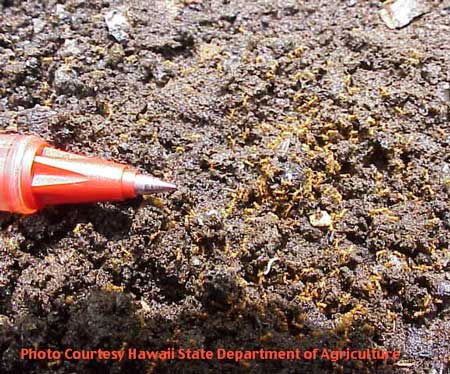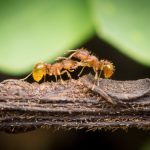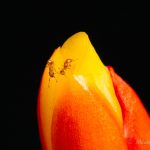Little Fire Ant (LFA)
Wasmannia auropunctata

- Regulatory Status: Hawaii Injurious Wildlife (HAR 124), HDOA Pest for Control (HAR 69A)
- What You Can Do: Learn about how to identify LFA. Report and send in ant samples (see below). Check your plants for ants. Treat your property if you have an infestation. Find out what you can do on your island at stoptheant.org.
- Report little fire ants by collecting and sending in ants (Request an Ant Collection Kit)
- Prevention and Control Category: KISC Target Species. OISC Target Species. MoMISC EDRR Species. MISC Target Species.
Photo credit below from left to right (1-3. Melody Euaparadorn, Hawaii Ant Lab, 4. DLNR)
- Two Little Fire Ants meeting on a trail. Ants use special chemical signals called pheromones and touch to communicate with one another.
- Little Fire Ants form supercolonies with an enormous number of wokers making it easier for LFA to dominate an area.
- Little Fire Ants visiting a ginger flower to collect energy rich nectar.
- Little Fire Ant vs. Tropical Fire Ant size comparison.

DESCRIPTION:
- This ant is a uniform yellow-red to light brown in color, all workers are 1.5 mm in length (half the size of a sesame seed, or as long as a penny is thick, about 1/16”).
- Little fire ant does NOT build mounded dirt nests, and nests in a variety of habitats including in trees, around potted plants, irrigation lines, and in electrical boxes.
- They are slow-moving and easily dislodged from leaves, plants, and trees.
- They often sting on neck, arms, and torso (LFA infestations are often discovered when ants fall on people from above).
- Check out the Hawaii Ant Lab Field Guide on how to identify Little fire ants here.
- “Prefers moist conditions, forming colonies on the ground AND in trees.” (MISC)
- “It is native to South America but has invaded tropical and sub-tropical regions around the world from Africa to Israel to Australia to the Galapagos Islands. It is even known as a greenhouse pest in colder areas such as Europe and Canada!” (BIISC)
- “Through DNA studies, we can see that the LFA we have in Hawai‛i are most closely related to invasive colonies in Florida. It is thought that they were accidentally introduced to Hawai‛i Island on shipments of plants to nurseries in Puna sometime in the 1990s.” (BIISC)
IMPACTS:
- Delivers a painful sting when disturbed. Welts can last for weeks.
- Infests agricultural fields and farms, where they damage crops and sting workers.
- Promotes plant pests such as aphids, white flies and scale insects, which secrete plant sap that the ants eat. In turn, the ants protect these insects from natural predators and parasites.
- Can infest houses, beds, furniture and food.
- They may sting, and even blind, pets such as cats and dogs.
- “Infest bee hives, preying on the larvae and eventually destroy the hive.” (MISC)
- Costly and difficult for property owners to manage large infestations. Often requires repeated and on-going treatment, especially where infestation is widespread on Hawaiʻi Island.
- In the Galapagos, eats tortoise hatchlings and attacks the eyes of adult tortoises.
ERADICATION & CONTROL METHODS:
- “It is important to survey your property when bringing in new plants/materials, if you suspect LFA on your property, or if neighboring properties have an LFA infestation. LFA are tiny and can be living on your property unnoticed.” (BIISC – Find info on how to survey here)
- There are multiple different products for treating LFA such as granular baits, insect growth regulators, and barrier treatments.
- “Colonies can recover after a single application, so any effective plan will involve multiple applications. Whatever bait product you choose, plan to treat your property with a bait product every 4-6 weeks for a year in order to wipe out all of the nests!” (BIISC)
WHAT YOU CAN DO:
- Collect and submit ants for identification if you suspect you may have little fire ants or a new species of pest ant.
- Check any new and incoming plants to your property for ants. Infestations are cheaper and easier to deal with when found quickly.
- Survey your property at least once a year for ants. Treat your property if you have an infestation.
- Oʻahu: Submit your ant samples to the the Oʻahu Invasive Species Committee at 743 Ulukahiki St., Kailua, HI 96734.
- Maui county (Maui, Molokai, Lanaʻi) : Any ants suspected to be little fire ants should be collected and reported.
Reports can go to the Maui Invasive Species Committee (Or Molokai) or call the Statewide Pest Hotline: 643-PEST (7378). - Kauaʻi: Report LFA to Kauaʻi Invasive Species Council at 808-821-1490 or [email protected] or HDOA at 643-PEST. Report any suspected Little Fire Ants immediately!
- Hawaiʻi Island: Hawai‘i Ant Lab (HAL) based in both Hilo and Kailua-Kona, can identify ants mailed or brought into their offices. As well as offering specific treatments plans for your property, site visits for industry (farmers, nurseries, etc.) and monthly workshops via zoom. Get involved with community groups, such as a neighborhood hui or attend a community information session.




